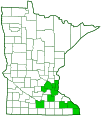greenhouse millipede
(Oxidus gracilis)
Conservation • Description • Habitat • Ecology • Distribution • Taxonomy
Conservation Status |
|
|||||||
| IUCN Red List | not listed |
|||||||
| NatureServe | NNA - Not applicable |
|||||||
| Minnesota | not listed |
|||||||
Description |
||
Greenhouse millipede is an exotic, small, flat-backed millipede. It is thought to be native to Japan, but it has been introduced around the world. It is now naturalized in Europe, western Asia, the Indian subcontinent, South Africa, New Zealand, North America, and South America. In the United States it is common east of the Great Plains and west of the Rocky Mountains. Between these regions it is also common in areas surrounding each of the large cities. Its spread is aided by shipments of garden soil. In Minnesota it has been recorded only in the southeast quarter of the state. It is found in areas with moist soil, including greenhouses, gardens, and leaf piles, especially in municipalities and urban environments. When disturbed it exudes a foul-smelling toxin. It is poisonous to predators but not to humans. The adult is ⅝″ to 13⁄16″ (16 to 21 mm) long and 1⁄16″ to 3⁄32″ (2.0 to 2.5 mm) wide. The body appears flattened when viewed from the side. The head is large and round. It bears a pair of antennae, a pair of mouthparts (first maxillae) that are fused together and serve as a lower lip, no second maxillae, and no eyes. There are 20 body rings and a total of 31 pairs of pale brown legs. Rings 1 through 4 are simple segments and are called segments. Ring 1 has no legs. Rings 2 and 3 have a single pair of legs. Ring 4 also has a single pair of legs but is the first segment to bear a pair of breathing pores (spiracles). Rings 5 through 18 are each composed of two segments that have been fused together and are called diplosegments. Each bear two pairs of legs and two pairs of spiracles. Ring 19 is a diplosegment but has no legs and no spiracles. Ring 20 is not a true segment. It is the anal ring and is called the telson. It bears no legs. On males, ring 7 has just a single pair of legs. The front pair has been modified into a pair of reproductive structures (gonopods). Each ring is covered above with a black to dark brown, hard, rigid plate (tergite). Each tergite has a well-developed, flattened, plate-like extension (paranotum) on each side. The paranota are mostly, or at least in part, the same color as the legs. They are rounded and blunt near the middle of the body, but they get longer and sharper approaching the rear of the body. On each diplosegment the middle portion of each tergite (metatergite) has a distinct horizontal groove and one or two rows of stiff hairs (setae). |
||
Size |
||
Total length: ⅝″ to 13⁄16″ (16 to 21 mm) |
||
Similar Species |
||
Habitat |
||
Areas with moist soil, especially in greenhouses, gardens, and leaf piles. |
||
Ecology |
||
Season |
||
Year round |
||
Behavior |
||
The flattened shape of the body allows the millipede to push its way between layers of leaves. |
||
Life Cycle |
||
|
||
Food |
||
Decaying leaves and wood |
||
Distribution |
||||
|
Sources |
|||
| 9/3/2023 | ||||
Occurrence |
||||
|
||||
Taxonomy |
|||
Subphylum |
Myriapoda (myriapods) | ||
Class |
Diplopoda (millipedes) | ||
| Subclass | Chilognatha | ||
| Infraclass | Helminthomorpha (worm-like millipedes) | ||
| Subterclass | Eugnatha | ||
| Superorder | Merocheta | ||
Order |
Polydesmida (flat-backed millipedes) | ||
Suborder |
Strongylosomatidea | ||
Family |
Paradoxosomatidae | ||
Subfamily |
Paradoxosomatinae | ||
Tribe |
Sulciferini | ||
Genus |
Oxidus | ||
Synonyms |
|||
Fontaria gracilis Kepolydesmus sontus Orthomorpha gracilis Paradesmus dasys |
|||
Common Names |
|||
garden millipede greenhouse millipede hothouse millipede short-flange millipede |
|||
Glossary
Maxillae
Paired mouth structures of arthropods located immediately behind the mandible and used for tasting and manipulating food. “Under-jaws”.
Seta
A stiff, hair-like process on the outer surface of an organism. In Lepidoptera: A usually rigid bristle- or hair-like outgrowth used to sense touch. In mosses: The stalk supporting a spore-bearing capsule and supplying it with nutrients. Plural: setae.
Spiracle
A small opening on the surface of an insect through which the insect breathes.
Visitor Photos |
|||||
Share your photo of this Myriapod. |
|||||
| This button not working for you? Simply email us at info@MinnesotaSeasons.com. Attach one or more photos and, if you like, a caption. |
|||||
Alfredo Colon |
|||||
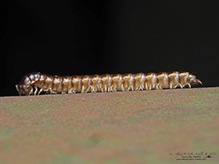 |
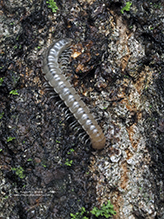 |
||||
Greg Watson |
|||||
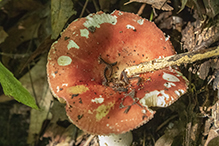 |
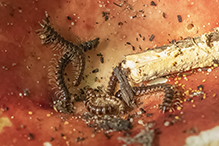 |
||||
MinnesotaSeasons.com Photos |
|||||
|
|||||

Slideshows |
||

Visitor Videos |
|||
Share your video of this Myriapod. |
|||
| This button not working for you? Simply email us at info@MinnesotaSeasons.com. Attach a video, a YouTube link, or a cloud storage link. |
|||
Other Videos |
|||
| The greenhouse millipede (Oxidus gracilis) by vj Nature and wildlife |
|||
About
Mar 27, 2020 The greenhouse millipede (Oxidus gracilis), also known as the hothouse millipede, short-flange millipede, or garden millipede, is a species of millipede in the family Paradoxosomatidae that has been widely introduced around the world, and is sometimes a pest in greenhouses. |
|||
| Oxidus Gracilis (Myriapoda Diplopoda Polydesmida Paradoxomatidae) Milpies AnimalandiaSCS |
|||
About
Nov 9, 2014 Oxidus Gracilis (Myriapoda Diplopoda Polydesmida Paradoxomatidae) comúnmente llamado milpiés. Fauna Ibérica de Extremadura Kingdom: Animalia |
|||
| Oxidus gracilis Greenhouse millipede (Paradoxosomatidae) Flat-backed Millipede DiegoDCvids |
|||
About
Jul 31, 2014 Greenhouse millipede: Oxidus gracilis (Arthropoda - Diplopoda - Polydesmida - Polydesmidae - Paradoxosomatidae - Sulciferini) diplópodo, milípede, artrópodes, animais herbívoros, detritívoros, paranota, tergum, Flat-backed Millipede, Florianópolis, Santa Catarina, Brasil |
|||


Created: 11/22/2022
Last Updated:
